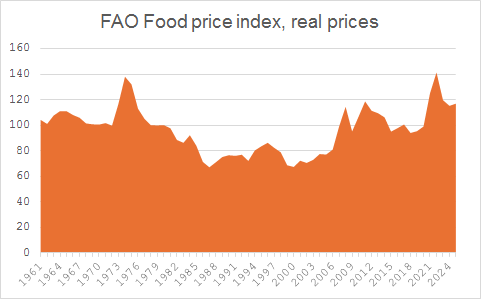Is 100 Years of Cheap Food Coming to an End? Understanding the Shift in Global Food Prices
For decades, the average consumer has enjoyed the benefits of inexpensive and accessible food. However, recent trends suggest that this era of affordability may be drawing to a close. In this engaging exploration, we’ll delve into the factors contributing to the rising costs of food globally and what it means for consumers moving forward.
The Global Food Price Landscape: A Broader Perspective
When we examine global food prices, the narrative grows complex. While prices are rising dramatically in Europe and the USA, other regions display a more moderate increase. Historically, food prices trended downward for much of the past century, with notable spikes associated with oil price fluctuations. As Carey W. King articulates in The Economic Superorganism, "the cost of energy plus food has never been cheaper than around the year 2000." Read more.

Even the FAO food price index, often referred to as such, is essentially a commodity index reflecting wholesale prices of a variety of crucial food commodities, rather than the final products purchased by consumers. Learn more.
Hiking Prices: The Role of Fossil Fuels and Fertilizers
Rising Energy Costs
The interplay between food prices and energy costs is significant. As transportation expenses soar, two critical effects emerge: increased purchase costs for consumers and diminished competition in the marketplace, leading to higher prices overall. More than free trade policies, it has been the low cost of transportation that has propelled economic globalization.
Energy-intensive nitrogen fertilizers are also contributing factors. As prices rise, many farmers may reduce their fertilizer usage, resulting in lower yields and constrained supply. In the European Union (EU), stringent environmental and climate policies further exacerbate this situation, straining the agricultural sector.
Navigating the EU’s Nitrogen Trilemma
The EU’s regulatory environment poses multiple challenges to farmers. With various environmental regulations like the Nitrate Directive and the NEC Directive, together with the carbon trading scheme that raises production costs for fertilizers, the financial burden is heavy.
Moreover, the EU has curtailed its fossil gas imports, leading to higher pricing for liquid natural gas (LNG) compared to piped gas from Russia. These changes create tremendous pressure on EU fertilizer producers, making it increasingly challenging to compete with lower-cost Russian counterparts. The Russian government’s export tax serves to generate significant revenue in this scenario. Explore these implications.
A Vicious Cycle: The Energy-Food-Labor Link
As energy costs rise, they inevitably lead to increased food prices, which in turn compel higher labor costs. Although the agricultural sector employs a relatively small number of people, the entire food supply chain encompasses 1.23 billion people globally, with nearly half of the world’s population relying on agricultural livelihoods. Discover more here.
As one can see, this creates a self-reinforcing cycle of rising prices that impacts all aspects of life. Higher energy prices lead to increased food prices, which escalate labor costs and distribution expenses, culminating in further disruptions across supply chains.
The Climate Change Dimension
While climate change may not currently be wreaking havoc on food production on a global scale, its potential effects could soon manifest. Research primarily addresses future risks rather than immediate impacts. However, even minor fluctuations in weather can wreak havoc on food prices. Policies aimed at combating climate change, as evidenced by the EU’s regulatory framework, could significantly affect food production sustainability. It’s essential to recognize that climate policies come with a price tag, impacting farmers and consumers alike.
The Path Forward: A Shift Towards Localized Food Systems?
While rising prices present considerable challenges for consumers and policymakers, they may also pave the way for a much-needed transformation in our food systems. This shift could foster a return to localized food production, promoting self-sufficiency and revitalizing rural communities.
As we stand at this pivotal point in food economics, it’s critical to stay informed and consider how these dynamics influence our daily lives. The era of cheap food may be closing, but it also heralds an opportunity for systemic change. Can we adapt to a new reality where food costs reflect the true value of quality and sustainability? Only time will tell.






